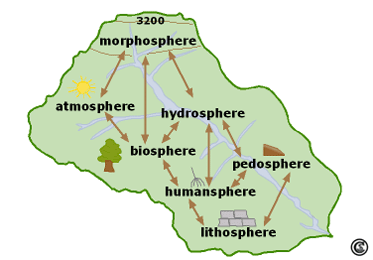Interaction of geospheres
Interaction of geospheres; arrows symbolise the interactions (not all interactions are illustrated).
Image Credit: Anette Stumptner 2007
Watersheds consists - like all ecosystems - of different geospheres:
- atmosphere;
- hydrosphere;
- lithosphere;
- morphosphere;
- pedosphere;
- biosphere;
- human sphere;
These spheres are not independent, they interact. For example, the characteristics and interactions of the atmo-, hydro-, litho-, morpho-, bio- and human sphere determine which soil is formed in the watershed (soil forming factors). In other watersheds with changed characteristics of geospheres (e.g., changed meteorological parameters) may the interactions of geospheres result in another soil type. Changes within a watershed (such as intensified resource use) may cause changed soil characteristics.
Thus, the characteristics and interactions of the geospheres shape the nature of a watershed. They thus also determine the availability of natural resources and their quality. A sufficient precipitation rate with moderately intensity may supply an adequate amount of water available for human use. If it really sufficient, is depending of the actual demand of water. On the other hand, inappropriate land use practices may degrade the soil and finally reduce the usable agricultural area. These interactions of geospheres are the reason why Integrated Watershed Management takes an integrated approach of natural resource management.
The interactions of geospheres are complex (see slope dynamics and river bed dynamics).



